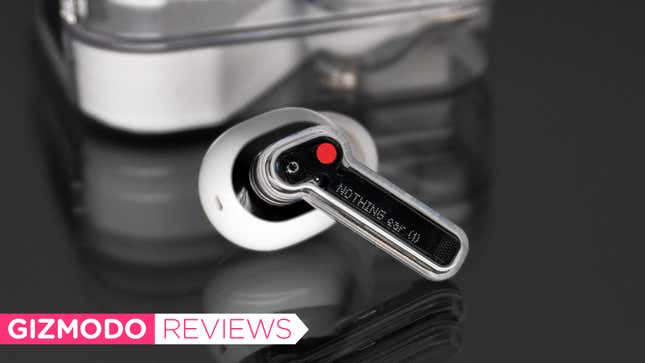
OnePlus co-founder Carl Pei is taking a OnePlus-esque approach to his new company, called Nothing. OnePlus established itself as a go-to brand for affordable smartphones with flagship features, and after months of hype, Nothing’s first product has arrived to deliver the same thing OnePlus’ smartphones did: solid hardware at a competitive price.
In just a few short years, the wireless earbuds market has exploded, and you can already get a pair of totally usable wireless buds for just $25, though you’d sacrifice many of the features that have helped make these devices so popular so quickly. If you want long battery life, excellent sound, wireless charging, and active noise cancellation, you’re still going to pay a premium for those features. Master & Dynamic’s MW08 Sport, arguably some of the best sounding, fully-featured wireless earbuds you can buy, will set you back a hefty $350, and even the long-in-the-tooth AirPods Pro are still $249. That’s a lot of money to spend on a device that’s so easy to lose. That’s why the $99 Nothing Ear (1) earbuds are genuinely interesting despite not really doing anything especially interesting.
A ‘90s-Inspired Design, Minus the Tackiness
With devices as small as wireless earbuds, there’s not a lot of room to innovate, and unless a company slaps a big logo on the outside of them, they all tend to look alike. It’s an issue that plagues smartphones, too, which is why they mostly all look like generic black rectangles.

Fight hair loss with science
Right now, you can get The Hair Revitalizing Complex Full Set for the price of the Refill. That’s just $98 for a 30-day supply, and $32 off the supplement’s normal price. This supplement is proven to deliver results. Augustinus Bader performed a six-month double blind trial that found those on the supplement had increased their hair count by 56%, hair shine by 100%, and saw a 98% reduction in hair damage compared to those who took a placebo.
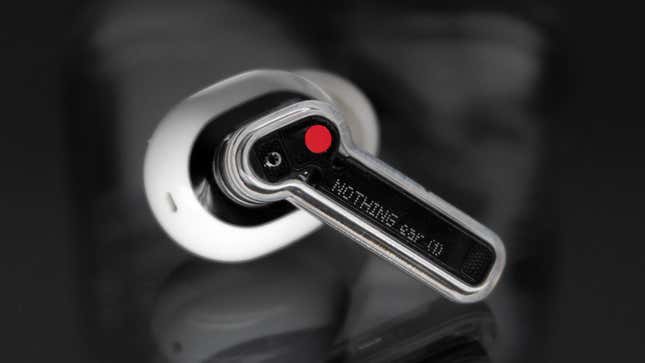
To Nothing’s credit, the Ear (1) earbuds do have a more distinct design than most, through the use of transparent plastic revealing some of the components inside the earbuds and their charging case. If you were a kid or teen in the late ‘80s and early ‘90s you probably had a small boombox or phone made from clear plastic, and while reviving that aesthetic could have come across as overly gimmicky (it still is), Nothing’s earbuds make it work.
Borrowing From Apple, but That’s a Good Thing

The Powerbeats Pro aside, at this point there are two basic ways to design a set of wireless earbuds. You can pack all of the electronics—batteries, antenna, driver, etc.—in a pod that sticks out of the user’s ears, or you can opt for something smaller with an extra downward pointing stem, a design that Apple originally introduced with the AirPods. Nothing has taken the latter approach with its own earbuds, and I personally find it provides a better weight balance that reduces the risks of the buds falling out, once you’ve found the best fit. The Ear (1) come with three sizes of silicone tips—the bare minimum these days—and while that doesn’t accommodate all potential users, you can always opt for third-party alternatives from companies like Comply.
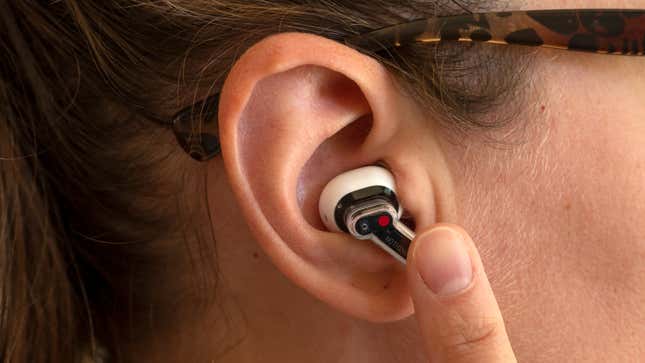
The Ear (1) look and feel very similar to Apple’s AirPods Pro, but I much prefer Nothing’s approach to on-bud controls. The AirPods Pro require you to squeeze a force sensor on the stem, while Nothing uses the more common tap approach that I find is less likely to dislodge the buds in the process. For volume adjustments, the Ear (1) also recognizes a finger sliding up and down the flat side of the stem, and while it doesn’t provide fine control over volume (it instead jumps up and down in small increments), it still works quite well.

There’s not much to dislike about the Ear (1)—Nothing has played it mostly safe with its first product. But the charging case is a bit on the bulky side, and is reminiscent of the packaging Apple’s classic corded earbuds used to ship in. The case does give the Ear (1) better battery life than the AirPods Pro—34 hours in total compared to 24—but it feels like Nothing could have reworked the layout inside to make it a little more compact.

That being said, the gratuitous use of clear plastic on the case looks quite nice, and I especially appreciate the color-coded dots that make it easy to know which earbud belongs in which charging spot. There are lots of times when you take a pair of wireless earbuds out, drop them on a desk, and forget which is the left and right side while you fumble to get them back into their case. That’s not an issue here.
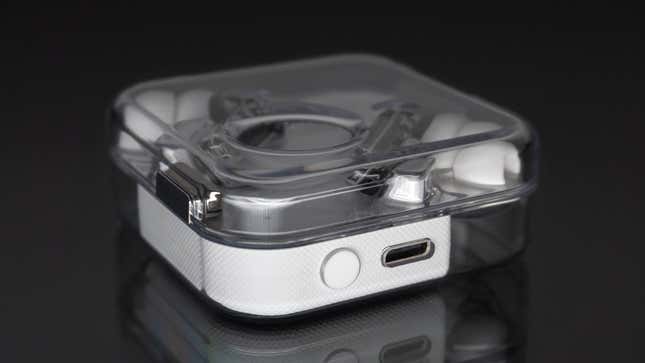
The ear (1) charging case can be quickly topped off using a USB-C cable, but wireless charging is also supported—something you don’t really see on sub-$100 wireless earbuds.
A Solid App With Some Neat Tricks
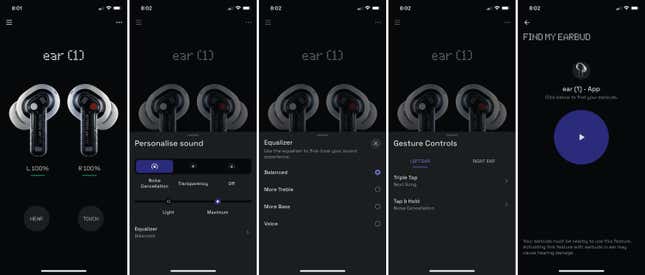
Something else you don’t see on sub-$100 wireless earbuds is an accompanying mobile app. In terms of functionality, the Ear (1) app for iOS and Android falls on the more basic side of things, but you get easy access controls for switching ANC modes, three alternate EQ settings if the default “Balanced” tuning isn’t doing it for you, and the ability to change what the tap gestures do. One welcome feature I haven’t seen before is a “Find my earbud” feature which causes each bud to emit a high-pitched tone making it easier to find. It’s not the loudest alert—these are earbuds, after all, not loudspeakers—but it will make a lost bud much easier to find as long as you’re in the same room.
Solid Audio and ANC Performance
If there’s one feature I prioritize over any other when it comes to wireless earbuds it’s the size of the drivers used, which is what creates the actual sound waves being pumped into your ears. The bigger the driver, the more air it can push, which improves the quality of the sound you’re going to hear. It’s why I’m such a fan of wireless earbuds like the Master & Dynamic MW08's, which use large 11mm drivers for excellent bass reproduction despite the relatively compact size of the buds themselves. But those will set you back $300.
I was pleasantly surprised to find that Nothing has opted for 11mm drivers in the Ear (1) as well. Does that mean they sound as good as the MW08s? Not quite. There is still quite a bit of extra thump when the beat drops at around the 30-second mark of the Tropic Remix of Surf Mesa’s “ily,” but I found Nothing’s earbuds to be tuned slightly more towards the higher end. In tracks like Lemon Jelly’s “Tune for Jack,” the high hats and tambourines were especially pronounced, which isn’t a bad thing, but your tastes may vary. The AirPods Pro provides a better overall balanced sound I think (as do even pricier alternatives) but the Ear (1) do much better at reproducing the low-end frequencies that sub-$100 earbuds always fail to deliver.
The active noise cancellation is also quite good, and very aggressive on low-end frequencies like the simulated noise of an airplane cabin blasted through a Bluetooth speaker. But higher-end frequencies are still present, like people talking, and slightly moreso than they are through the AirPods Pro. But unless you’re willing to go over the top with chunky earbuds like Sony did to improve noise-cancellation, the performance of ANC in earbuds will always lag behind larger over-ear headphones. However, the multiple microphones that power the ANC on the Ear (1) do result in excellent call quality, with most people I spoke to being unable to tell I was using earbuds during a call until I told them.
The Best Affordable Wireless Earbuds Out There
Given the features and sound performance, Nothing could have easily gotten away with charging $200 for the Ear (1), and even at $150 they would have provided some stiff competition to Apple and other established headphone makers. But these are without a doubt the best full-featured wireless earbuds on the market for less than $100. They’re not only an excellent option if you’re on a budget but want all the bells and whistles (the $130 Sennheiser CX True Wireless do sound better, but you don’t get ANC or wireless charging), but hopefully Nothing will put pressure on other wireless earbud makers to start offering full-featured alternatives at similarly competitive prices. Then we all win.